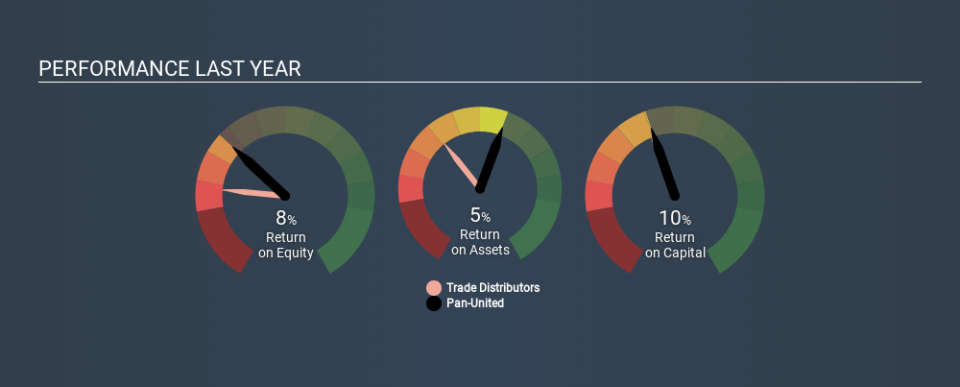Pan-United Corporation Ltd (SGX:P52) Earns Among The Best Returns In Its Industry

Today we'll look at Pan-United Corporation Ltd (SGX:P52) and reflect on its potential as an investment. To be precise, we'll consider its Return On Capital Employed (ROCE), as that will inform our view of the quality of the business.
First, we'll go over how we calculate ROCE. Then we'll compare its ROCE to similar companies. Finally, we'll look at how its current liabilities affect its ROCE.
Understanding Return On Capital Employed (ROCE)
ROCE measures the 'return' (pre-tax profit) a company generates from capital employed in its business. Generally speaking a higher ROCE is better. Overall, it is a valuable metric that has its flaws. Renowned investment researcher Michael Mauboussin has suggested that a high ROCE can indicate that 'one dollar invested in the company generates value of more than one dollar'.
So, How Do We Calculate ROCE?
Analysts use this formula to calculate return on capital employed:
Return on Capital Employed = Earnings Before Interest and Tax (EBIT) ÷ (Total Assets - Current Liabilities)
Or for Pan-United:
0.097 = S$28m ÷ (S$454m - S$170m) (Based on the trailing twelve months to September 2019.)
So, Pan-United has an ROCE of 9.7%.
Check out our latest analysis for Pan-United
Does Pan-United Have A Good ROCE?
When making comparisons between similar businesses, investors may find ROCE useful. In our analysis, Pan-United's ROCE is meaningfully higher than the 2.2% average in the Trade Distributors industry. We consider this a positive sign, because it suggests it uses capital more efficiently than similar companies. Setting aside the industry comparison for now, Pan-United's ROCE is mediocre in absolute terms, considering the risk of investing in stocks versus the safety of a bank account. Readers may find more attractive investment prospects elsewhere.
You can click on the image below to see (in greater detail) how Pan-United's past growth compares to other companies.
When considering ROCE, bear in mind that it reflects the past and does not necessarily predict the future. ROCE can be deceptive for cyclical businesses, as returns can look incredible in boom times, and terribly low in downturns. ROCE is only a point-in-time measure. How cyclical is Pan-United? You can see for yourself by looking at this free graph of past earnings, revenue and cash flow.
Do Pan-United's Current Liabilities Skew Its ROCE?
Short term (or current) liabilities, are things like supplier invoices, overdrafts, or tax bills that need to be paid within 12 months. Due to the way the ROCE equation works, having large bills due in the near term can make it look as though a company has less capital employed, and thus a higher ROCE than usual. To check the impact of this, we calculate if a company has high current liabilities relative to its total assets.
Pan-United has total assets of S$454m and current liabilities of S$170m. Therefore its current liabilities are equivalent to approximately 37% of its total assets. Pan-United has a medium level of current liabilities, which would boost its ROCE somewhat.
Our Take On Pan-United's ROCE
Despite this, its ROCE is still mediocre, and you may find more appealing investments elsewhere. But note: make sure you look for a great company, not just the first idea you come across. So take a peek at this free list of interesting companies with strong recent earnings growth (and a P/E ratio below 20).
If you are like me, then you will not want to miss this free list of growing companies that insiders are buying.
If you spot an error that warrants correction, please contact the editor at editorial-team@simplywallst.com. This article by Simply Wall St is general in nature. It does not constitute a recommendation to buy or sell any stock, and does not take account of your objectives, or your financial situation. Simply Wall St has no position in the stocks mentioned.
We aim to bring you long-term focused research analysis driven by fundamental data. Note that our analysis may not factor in the latest price-sensitive company announcements or qualitative material. Thank you for reading.


